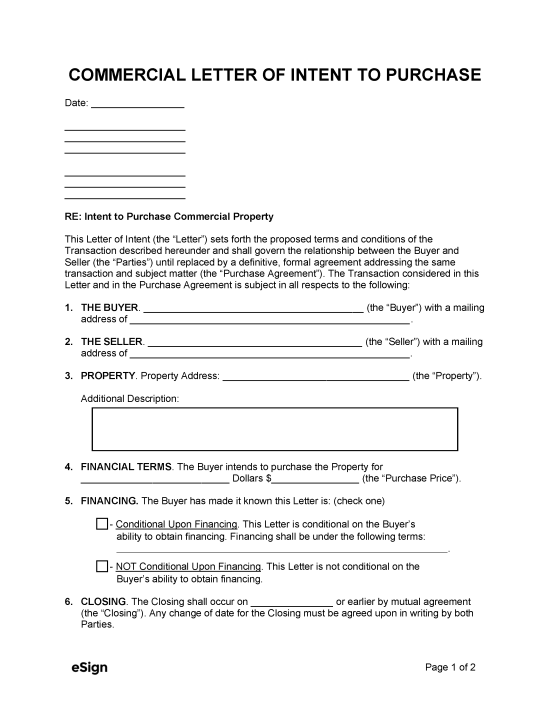

A commercial letter of intent to purchase is a document that presents a buyer’s intention to purchase a commercial property. The letter acts as an opening to negotiations between the buyer and seller. A letter of intent (LOI) is often drafted following a viewing of the property and a discussion of purchase conditions with the seller. By writing a letter to present their offer, the buyer can speed up negotiations and demonstrate their seriousness to the seller.
An LOI to purchase commercial real estate will generally include the following information:
[SENDER (i.e., BUYER/LESSEE) NAME]
[SENDER STREET ADDRESS]
[SENDER CITY, STATE, ZIP]
[RECIPIENT (i.e., PROPERTY OWNER/LESSOR) NAME]
[RECIPIENT STREET ADDRESS]
[RECIPIENT CITY, STATE, ZIP]
RE: Intent to Purchase Property
This Letter of Intent (the “Letter”) sets forth the proposed terms and conditions of the transaction described hereunder and shall govern the relationship between the Buyer and Seller (the “Parties”) until replaced by a definitive, formal agreement addressing the same transaction and subject matter (the “Definitive Agreement”). The transaction considered in this Letter and in the Definitive Agreement is subject in all respects to the following:
Please note: Any sections that do not apply may be struck through or deleted.
1. THE BUYER. [BUYER NAME] (the “Buyer” or “Lessee”) with a mailing address of [BUYER MAILING ADDRESS] .
2. THE SELLER. [SELLER NAME] (the “Seller” or “Lessor”) with a mailing address of [SELLER MAILING ADDRESS] .
3. TRANSACTION . This Letter is for the purchase of the Property located at [PROPERTY ADDRESS] (the “Property”) for $[AMOUNT] (the “Purchase Price”).
4. FINANCING. This Letter i s: ☐ – Conditional Upon Financing ☐ – Not Conditional Upon Financing.
5. CLOSING. The Closing shall occur on [DATE] (the “Closing”). Any change of date for the Closing must be agreed upon in writing by both Parties.
6. CLOSING COSTS. All costs associated with the Closing shall be the responsibility of (check one) ☐ the Buyer ☐ the Seller ☐ the Parties each bearing their own expenses.
7. POSSESSION. Possession of the Property shall be given on [DATE] (the “Possession”). Any change of date for the Possession must be agreed upon in writing by the Buyer and Seller.
8. STANDSTILL AGREEMENT. Following the execution of this Letter, and until Closing, the Seller shall not negotiate for the sale of the Property with any other party unless either the Parties agree in writing to terminate this Letter, or the Parties fail to sign a Purchase Agreement by [DATE] .
9. INTENTION OF THE PARTIES. This Letter sets forth the intentions of the Parties to use reasonable efforts to negotiate, in good faith, a Definitive Agreement with respect to all matters herein. Notwithstanding paragraphs 4 and 8 through 11, which shall be legally binding, any legal obligations with respect to all other matters shall only arise if and when the Parties execute and deliver a Definitive Agreement.
10. GOVERNING LAW. This Letter shall be governed under the laws of the State of [STATE NAME] .
11. SIGNATURES.
Seller Signature: ____________________________
Date: [MM/DD/YYYY] Print Name: [SELLER PRINTED NAME]
Buyer Signature: ____________________________
Date: [MM/DD/YYYY] Print Name: [BUYER PRINTED NAME]
An LOI to purchase commercial property acts as a bridge between the buyer’s offer and the drafting and signing of a final purchase agreement . Before writing an LOI, the buyer will generally view the premises and talk to the seller about the asking price, utilities, and other property details relevant to their business.
If the buyer is interested in purchasing the property, they can draft an LOI to outline the terms of the proposed transaction and begin negotiations . The letter can then be delivered to the seller for review.